Economic Factors, Business Activities, and Global Economy Challenges
VerifiedAdded on 2023/06/06
|8
|2597
|464
Report
AI Summary
This report delves into the multifaceted relationship between economic factors and business activities within the context of a global economy. It examines the influence of fiscal policies, measuring economic growth, and the impact of interest rate changes on businesses. The report explores different types of unemployment, analyzes the stages of the economic cycle, and discusses the concept of sustainable economic growth, including methods for achieving it. Furthermore, it compares and contrasts monopoly and perfect competition market structures, evaluating their desirability. The report provides a comprehensive analysis of how economic conditions shape business operations and the challenges businesses face in the current global environment, supported by relevant references.
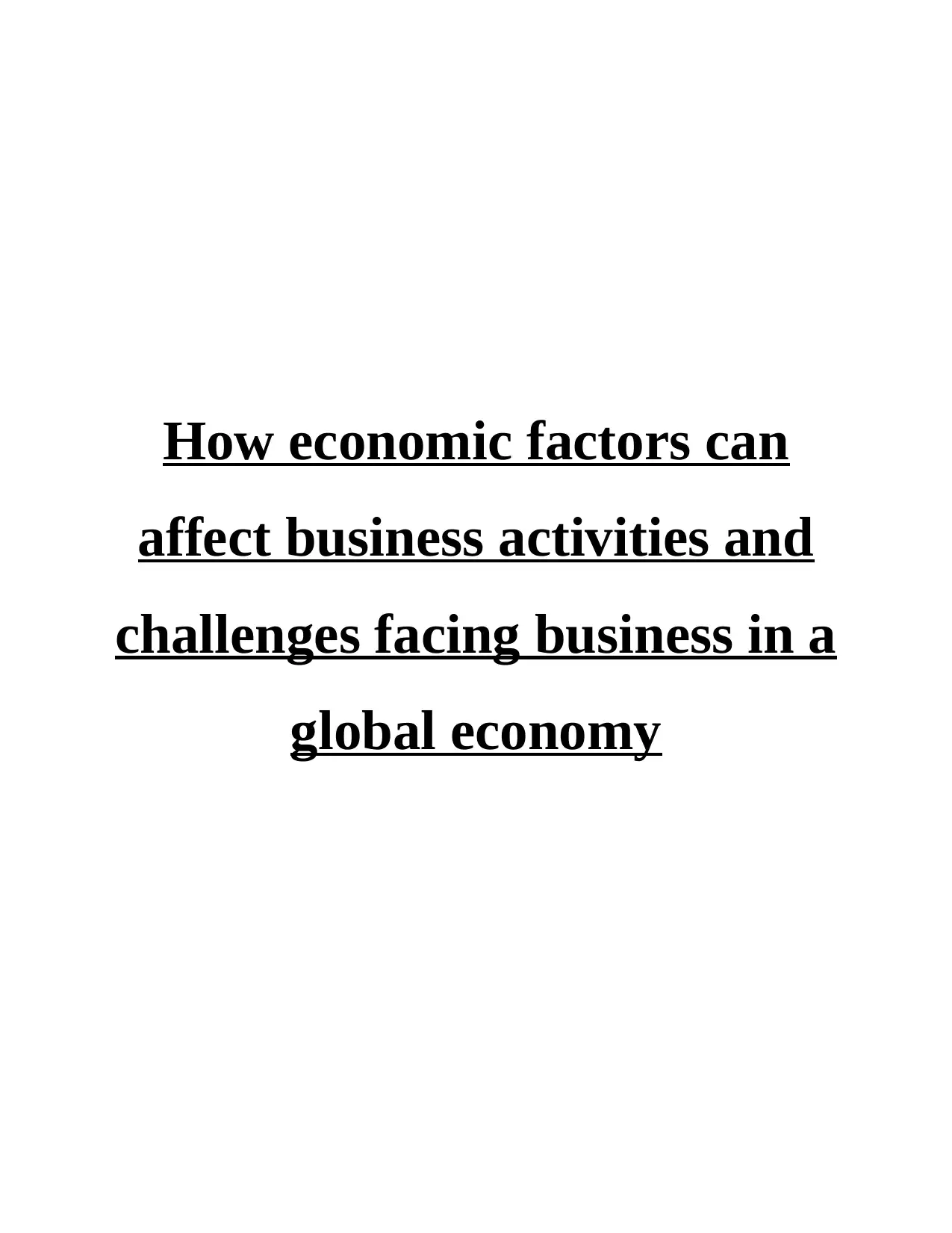
How economic factors can
affect business activities and
challenges facing business in a
global economy
affect business activities and
challenges facing business in a
global economy
Secure Best Marks with AI Grader
Need help grading? Try our AI Grader for instant feedback on your assignments.
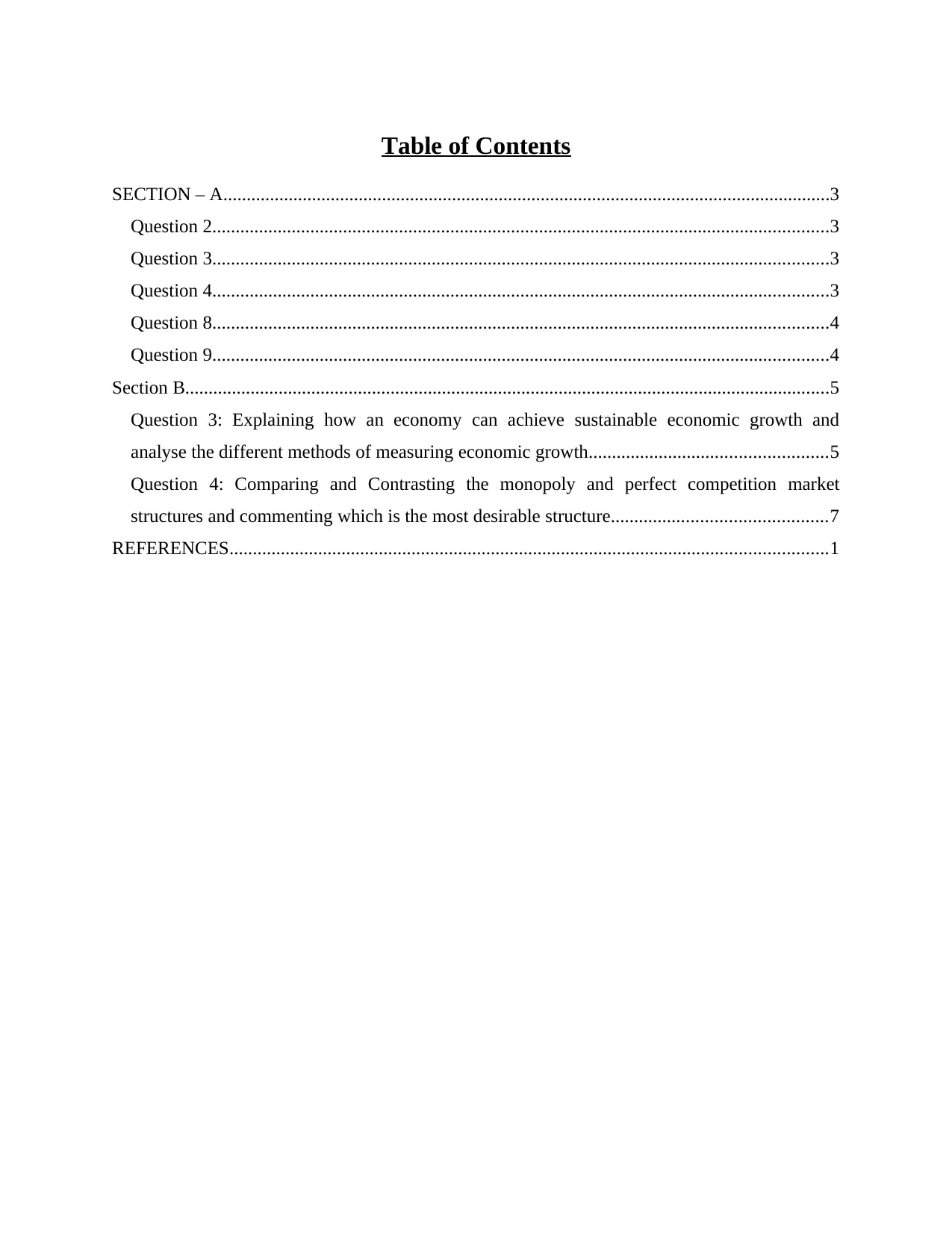
Table of Contents
SECTION – A..................................................................................................................................3
Question 2....................................................................................................................................3
Question 3....................................................................................................................................3
Question 4....................................................................................................................................3
Question 8....................................................................................................................................4
Question 9....................................................................................................................................4
Section B..........................................................................................................................................5
Question 3: Explaining how an economy can achieve sustainable economic growth and
analyse the different methods of measuring economic growth...................................................5
Question 4: Comparing and Contrasting the monopoly and perfect competition market
structures and commenting which is the most desirable structure..............................................7
REFERENCES................................................................................................................................1
SECTION – A..................................................................................................................................3
Question 2....................................................................................................................................3
Question 3....................................................................................................................................3
Question 4....................................................................................................................................3
Question 8....................................................................................................................................4
Question 9....................................................................................................................................4
Section B..........................................................................................................................................5
Question 3: Explaining how an economy can achieve sustainable economic growth and
analyse the different methods of measuring economic growth...................................................5
Question 4: Comparing and Contrasting the monopoly and perfect competition market
structures and commenting which is the most desirable structure..............................................7
REFERENCES................................................................................................................................1
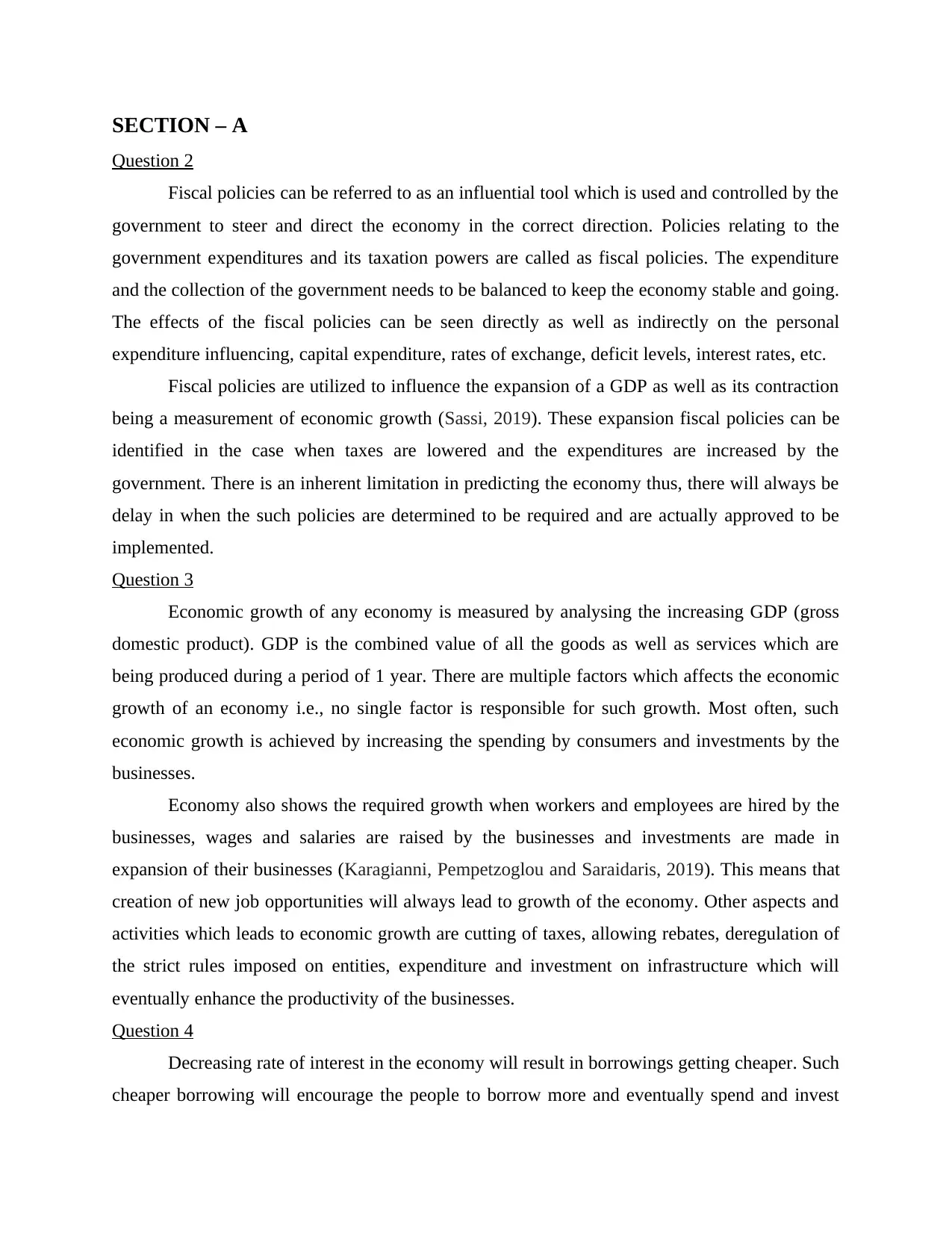
SECTION – A
Question 2
Fiscal policies can be referred to as an influential tool which is used and controlled by the
government to steer and direct the economy in the correct direction. Policies relating to the
government expenditures and its taxation powers are called as fiscal policies. The expenditure
and the collection of the government needs to be balanced to keep the economy stable and going.
The effects of the fiscal policies can be seen directly as well as indirectly on the personal
expenditure influencing, capital expenditure, rates of exchange, deficit levels, interest rates, etc.
Fiscal policies are utilized to influence the expansion of a GDP as well as its contraction
being a measurement of economic growth (Sassi, 2019). These expansion fiscal policies can be
identified in the case when taxes are lowered and the expenditures are increased by the
government. There is an inherent limitation in predicting the economy thus, there will always be
delay in when the such policies are determined to be required and are actually approved to be
implemented.
Question 3
Economic growth of any economy is measured by analysing the increasing GDP (gross
domestic product). GDP is the combined value of all the goods as well as services which are
being produced during a period of 1 year. There are multiple factors which affects the economic
growth of an economy i.e., no single factor is responsible for such growth. Most often, such
economic growth is achieved by increasing the spending by consumers and investments by the
businesses.
Economy also shows the required growth when workers and employees are hired by the
businesses, wages and salaries are raised by the businesses and investments are made in
expansion of their businesses (Karagianni, Pempetzoglou and Saraidaris, 2019). This means that
creation of new job opportunities will always lead to growth of the economy. Other aspects and
activities which leads to economic growth are cutting of taxes, allowing rebates, deregulation of
the strict rules imposed on entities, expenditure and investment on infrastructure which will
eventually enhance the productivity of the businesses.
Question 4
Decreasing rate of interest in the economy will result in borrowings getting cheaper. Such
cheaper borrowing will encourage the people to borrow more and eventually spend and invest
Question 2
Fiscal policies can be referred to as an influential tool which is used and controlled by the
government to steer and direct the economy in the correct direction. Policies relating to the
government expenditures and its taxation powers are called as fiscal policies. The expenditure
and the collection of the government needs to be balanced to keep the economy stable and going.
The effects of the fiscal policies can be seen directly as well as indirectly on the personal
expenditure influencing, capital expenditure, rates of exchange, deficit levels, interest rates, etc.
Fiscal policies are utilized to influence the expansion of a GDP as well as its contraction
being a measurement of economic growth (Sassi, 2019). These expansion fiscal policies can be
identified in the case when taxes are lowered and the expenditures are increased by the
government. There is an inherent limitation in predicting the economy thus, there will always be
delay in when the such policies are determined to be required and are actually approved to be
implemented.
Question 3
Economic growth of any economy is measured by analysing the increasing GDP (gross
domestic product). GDP is the combined value of all the goods as well as services which are
being produced during a period of 1 year. There are multiple factors which affects the economic
growth of an economy i.e., no single factor is responsible for such growth. Most often, such
economic growth is achieved by increasing the spending by consumers and investments by the
businesses.
Economy also shows the required growth when workers and employees are hired by the
businesses, wages and salaries are raised by the businesses and investments are made in
expansion of their businesses (Karagianni, Pempetzoglou and Saraidaris, 2019). This means that
creation of new job opportunities will always lead to growth of the economy. Other aspects and
activities which leads to economic growth are cutting of taxes, allowing rebates, deregulation of
the strict rules imposed on entities, expenditure and investment on infrastructure which will
eventually enhance the productivity of the businesses.
Question 4
Decreasing rate of interest in the economy will result in borrowings getting cheaper. Such
cheaper borrowing will encourage the people to borrow more and eventually spend and invest
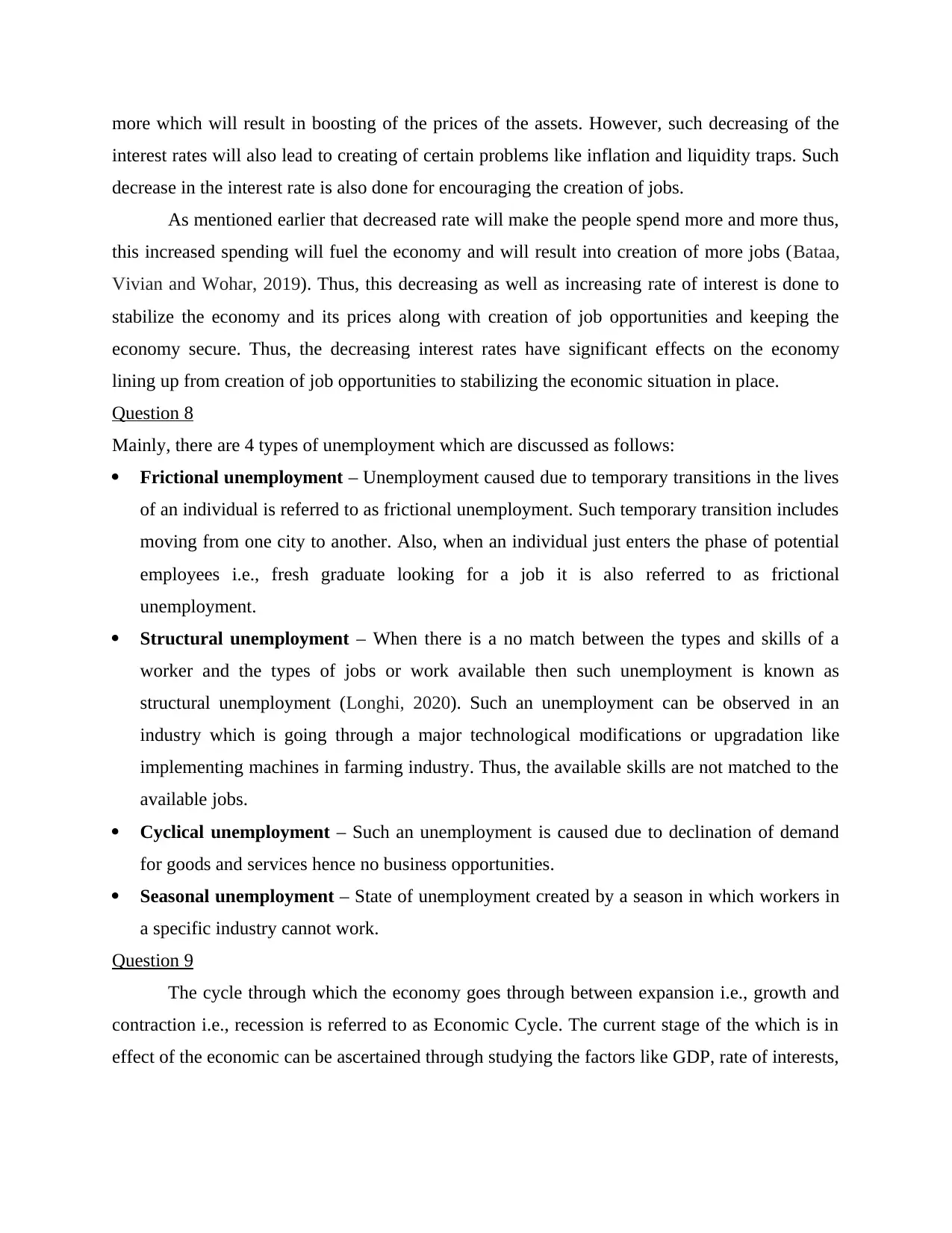
more which will result in boosting of the prices of the assets. However, such decreasing of the
interest rates will also lead to creating of certain problems like inflation and liquidity traps. Such
decrease in the interest rate is also done for encouraging the creation of jobs.
As mentioned earlier that decreased rate will make the people spend more and more thus,
this increased spending will fuel the economy and will result into creation of more jobs (Bataa,
Vivian and Wohar, 2019). Thus, this decreasing as well as increasing rate of interest is done to
stabilize the economy and its prices along with creation of job opportunities and keeping the
economy secure. Thus, the decreasing interest rates have significant effects on the economy
lining up from creation of job opportunities to stabilizing the economic situation in place.
Question 8
Mainly, there are 4 types of unemployment which are discussed as follows:
Frictional unemployment – Unemployment caused due to temporary transitions in the lives
of an individual is referred to as frictional unemployment. Such temporary transition includes
moving from one city to another. Also, when an individual just enters the phase of potential
employees i.e., fresh graduate looking for a job it is also referred to as frictional
unemployment.
Structural unemployment – When there is a no match between the types and skills of a
worker and the types of jobs or work available then such unemployment is known as
structural unemployment (Longhi, 2020). Such an unemployment can be observed in an
industry which is going through a major technological modifications or upgradation like
implementing machines in farming industry. Thus, the available skills are not matched to the
available jobs.
Cyclical unemployment – Such an unemployment is caused due to declination of demand
for goods and services hence no business opportunities.
Seasonal unemployment – State of unemployment created by a season in which workers in
a specific industry cannot work.
Question 9
The cycle through which the economy goes through between expansion i.e., growth and
contraction i.e., recession is referred to as Economic Cycle. The current stage of the which is in
effect of the economic can be ascertained through studying the factors like GDP, rate of interests,
interest rates will also lead to creating of certain problems like inflation and liquidity traps. Such
decrease in the interest rate is also done for encouraging the creation of jobs.
As mentioned earlier that decreased rate will make the people spend more and more thus,
this increased spending will fuel the economy and will result into creation of more jobs (Bataa,
Vivian and Wohar, 2019). Thus, this decreasing as well as increasing rate of interest is done to
stabilize the economy and its prices along with creation of job opportunities and keeping the
economy secure. Thus, the decreasing interest rates have significant effects on the economy
lining up from creation of job opportunities to stabilizing the economic situation in place.
Question 8
Mainly, there are 4 types of unemployment which are discussed as follows:
Frictional unemployment – Unemployment caused due to temporary transitions in the lives
of an individual is referred to as frictional unemployment. Such temporary transition includes
moving from one city to another. Also, when an individual just enters the phase of potential
employees i.e., fresh graduate looking for a job it is also referred to as frictional
unemployment.
Structural unemployment – When there is a no match between the types and skills of a
worker and the types of jobs or work available then such unemployment is known as
structural unemployment (Longhi, 2020). Such an unemployment can be observed in an
industry which is going through a major technological modifications or upgradation like
implementing machines in farming industry. Thus, the available skills are not matched to the
available jobs.
Cyclical unemployment – Such an unemployment is caused due to declination of demand
for goods and services hence no business opportunities.
Seasonal unemployment – State of unemployment created by a season in which workers in
a specific industry cannot work.
Question 9
The cycle through which the economy goes through between expansion i.e., growth and
contraction i.e., recession is referred to as Economic Cycle. The current stage of the which is in
effect of the economic can be ascertained through studying the factors like GDP, rate of interests,
Secure Best Marks with AI Grader
Need help grading? Try our AI Grader for instant feedback on your assignments.
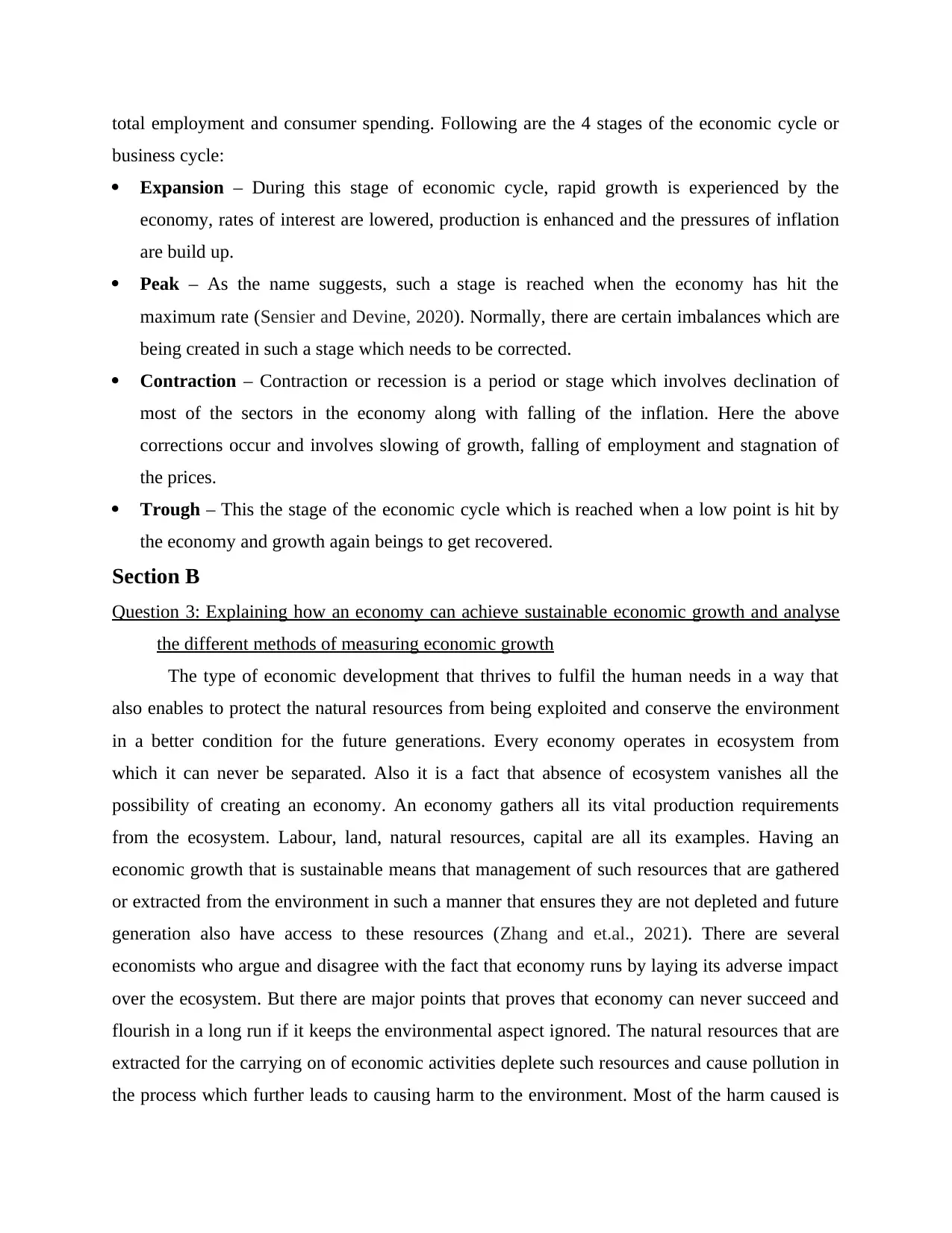
total employment and consumer spending. Following are the 4 stages of the economic cycle or
business cycle:
Expansion – During this stage of economic cycle, rapid growth is experienced by the
economy, rates of interest are lowered, production is enhanced and the pressures of inflation
are build up.
Peak – As the name suggests, such a stage is reached when the economy has hit the
maximum rate (Sensier and Devine, 2020). Normally, there are certain imbalances which are
being created in such a stage which needs to be corrected.
Contraction – Contraction or recession is a period or stage which involves declination of
most of the sectors in the economy along with falling of the inflation. Here the above
corrections occur and involves slowing of growth, falling of employment and stagnation of
the prices.
Trough – This the stage of the economic cycle which is reached when a low point is hit by
the economy and growth again beings to get recovered.
Section B
Question 3: Explaining how an economy can achieve sustainable economic growth and analyse
the different methods of measuring economic growth
The type of economic development that thrives to fulfil the human needs in a way that
also enables to protect the natural resources from being exploited and conserve the environment
in a better condition for the future generations. Every economy operates in ecosystem from
which it can never be separated. Also it is a fact that absence of ecosystem vanishes all the
possibility of creating an economy. An economy gathers all its vital production requirements
from the ecosystem. Labour, land, natural resources, capital are all its examples. Having an
economic growth that is sustainable means that management of such resources that are gathered
or extracted from the environment in such a manner that ensures they are not depleted and future
generation also have access to these resources (Zhang and et.al., 2021). There are several
economists who argue and disagree with the fact that economy runs by laying its adverse impact
over the ecosystem. But there are major points that proves that economy can never succeed and
flourish in a long run if it keeps the environmental aspect ignored. The natural resources that are
extracted for the carrying on of economic activities deplete such resources and cause pollution in
the process which further leads to causing harm to the environment. Most of the harm caused is
business cycle:
Expansion – During this stage of economic cycle, rapid growth is experienced by the
economy, rates of interest are lowered, production is enhanced and the pressures of inflation
are build up.
Peak – As the name suggests, such a stage is reached when the economy has hit the
maximum rate (Sensier and Devine, 2020). Normally, there are certain imbalances which are
being created in such a stage which needs to be corrected.
Contraction – Contraction or recession is a period or stage which involves declination of
most of the sectors in the economy along with falling of the inflation. Here the above
corrections occur and involves slowing of growth, falling of employment and stagnation of
the prices.
Trough – This the stage of the economic cycle which is reached when a low point is hit by
the economy and growth again beings to get recovered.
Section B
Question 3: Explaining how an economy can achieve sustainable economic growth and analyse
the different methods of measuring economic growth
The type of economic development that thrives to fulfil the human needs in a way that
also enables to protect the natural resources from being exploited and conserve the environment
in a better condition for the future generations. Every economy operates in ecosystem from
which it can never be separated. Also it is a fact that absence of ecosystem vanishes all the
possibility of creating an economy. An economy gathers all its vital production requirements
from the ecosystem. Labour, land, natural resources, capital are all its examples. Having an
economic growth that is sustainable means that management of such resources that are gathered
or extracted from the environment in such a manner that ensures they are not depleted and future
generation also have access to these resources (Zhang and et.al., 2021). There are several
economists who argue and disagree with the fact that economy runs by laying its adverse impact
over the ecosystem. But there are major points that proves that economy can never succeed and
flourish in a long run if it keeps the environmental aspect ignored. The natural resources that are
extracted for the carrying on of economic activities deplete such resources and cause pollution in
the process which further leads to causing harm to the environment. Most of the harm caused is
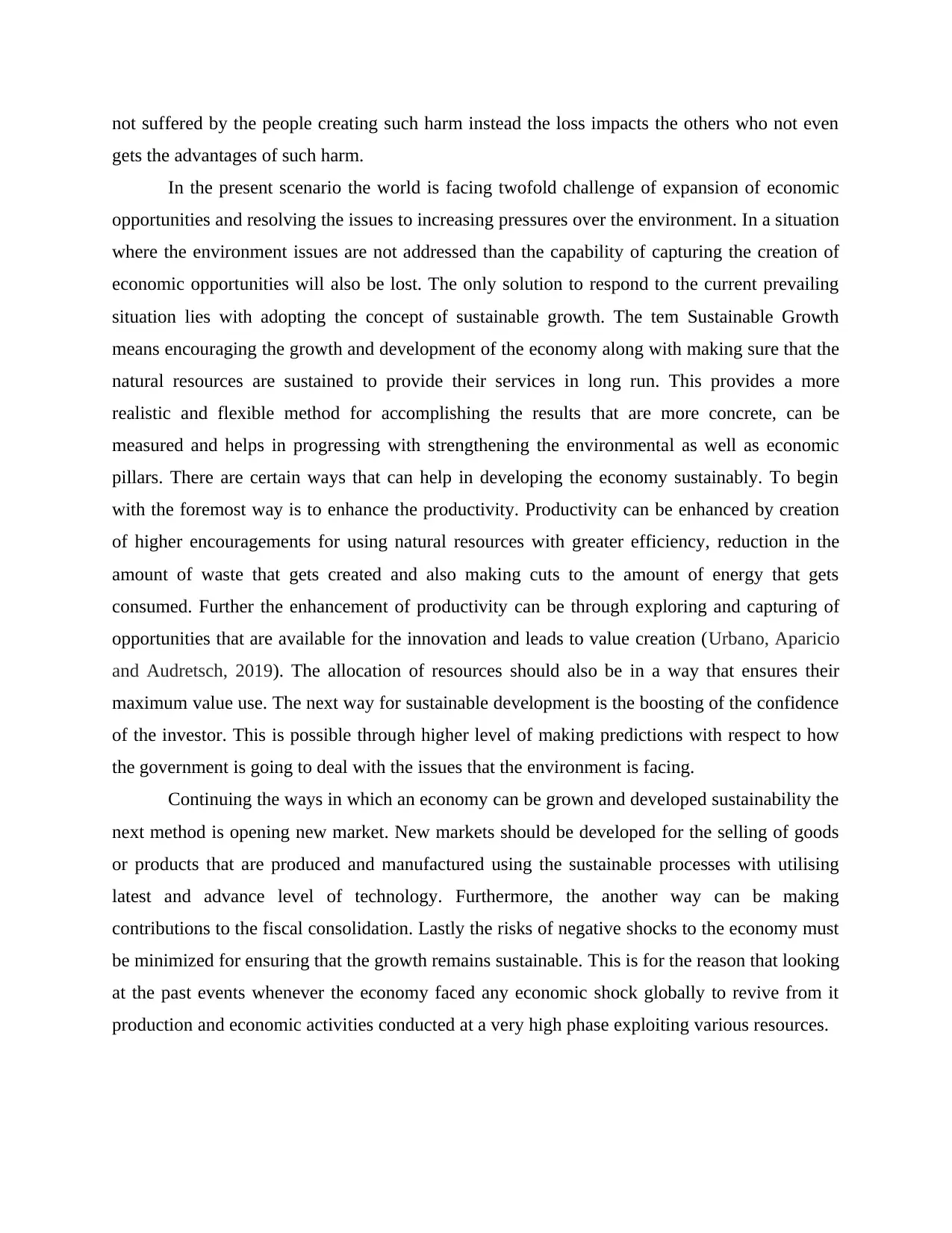
not suffered by the people creating such harm instead the loss impacts the others who not even
gets the advantages of such harm.
In the present scenario the world is facing twofold challenge of expansion of economic
opportunities and resolving the issues to increasing pressures over the environment. In a situation
where the environment issues are not addressed than the capability of capturing the creation of
economic opportunities will also be lost. The only solution to respond to the current prevailing
situation lies with adopting the concept of sustainable growth. The tem Sustainable Growth
means encouraging the growth and development of the economy along with making sure that the
natural resources are sustained to provide their services in long run. This provides a more
realistic and flexible method for accomplishing the results that are more concrete, can be
measured and helps in progressing with strengthening the environmental as well as economic
pillars. There are certain ways that can help in developing the economy sustainably. To begin
with the foremost way is to enhance the productivity. Productivity can be enhanced by creation
of higher encouragements for using natural resources with greater efficiency, reduction in the
amount of waste that gets created and also making cuts to the amount of energy that gets
consumed. Further the enhancement of productivity can be through exploring and capturing of
opportunities that are available for the innovation and leads to value creation (Urbano, Aparicio
and Audretsch, 2019). The allocation of resources should also be in a way that ensures their
maximum value use. The next way for sustainable development is the boosting of the confidence
of the investor. This is possible through higher level of making predictions with respect to how
the government is going to deal with the issues that the environment is facing.
Continuing the ways in which an economy can be grown and developed sustainability the
next method is opening new market. New markets should be developed for the selling of goods
or products that are produced and manufactured using the sustainable processes with utilising
latest and advance level of technology. Furthermore, the another way can be making
contributions to the fiscal consolidation. Lastly the risks of negative shocks to the economy must
be minimized for ensuring that the growth remains sustainable. This is for the reason that looking
at the past events whenever the economy faced any economic shock globally to revive from it
production and economic activities conducted at a very high phase exploiting various resources.
gets the advantages of such harm.
In the present scenario the world is facing twofold challenge of expansion of economic
opportunities and resolving the issues to increasing pressures over the environment. In a situation
where the environment issues are not addressed than the capability of capturing the creation of
economic opportunities will also be lost. The only solution to respond to the current prevailing
situation lies with adopting the concept of sustainable growth. The tem Sustainable Growth
means encouraging the growth and development of the economy along with making sure that the
natural resources are sustained to provide their services in long run. This provides a more
realistic and flexible method for accomplishing the results that are more concrete, can be
measured and helps in progressing with strengthening the environmental as well as economic
pillars. There are certain ways that can help in developing the economy sustainably. To begin
with the foremost way is to enhance the productivity. Productivity can be enhanced by creation
of higher encouragements for using natural resources with greater efficiency, reduction in the
amount of waste that gets created and also making cuts to the amount of energy that gets
consumed. Further the enhancement of productivity can be through exploring and capturing of
opportunities that are available for the innovation and leads to value creation (Urbano, Aparicio
and Audretsch, 2019). The allocation of resources should also be in a way that ensures their
maximum value use. The next way for sustainable development is the boosting of the confidence
of the investor. This is possible through higher level of making predictions with respect to how
the government is going to deal with the issues that the environment is facing.
Continuing the ways in which an economy can be grown and developed sustainability the
next method is opening new market. New markets should be developed for the selling of goods
or products that are produced and manufactured using the sustainable processes with utilising
latest and advance level of technology. Furthermore, the another way can be making
contributions to the fiscal consolidation. Lastly the risks of negative shocks to the economy must
be minimized for ensuring that the growth remains sustainable. This is for the reason that looking
at the past events whenever the economy faced any economic shock globally to revive from it
production and economic activities conducted at a very high phase exploiting various resources.
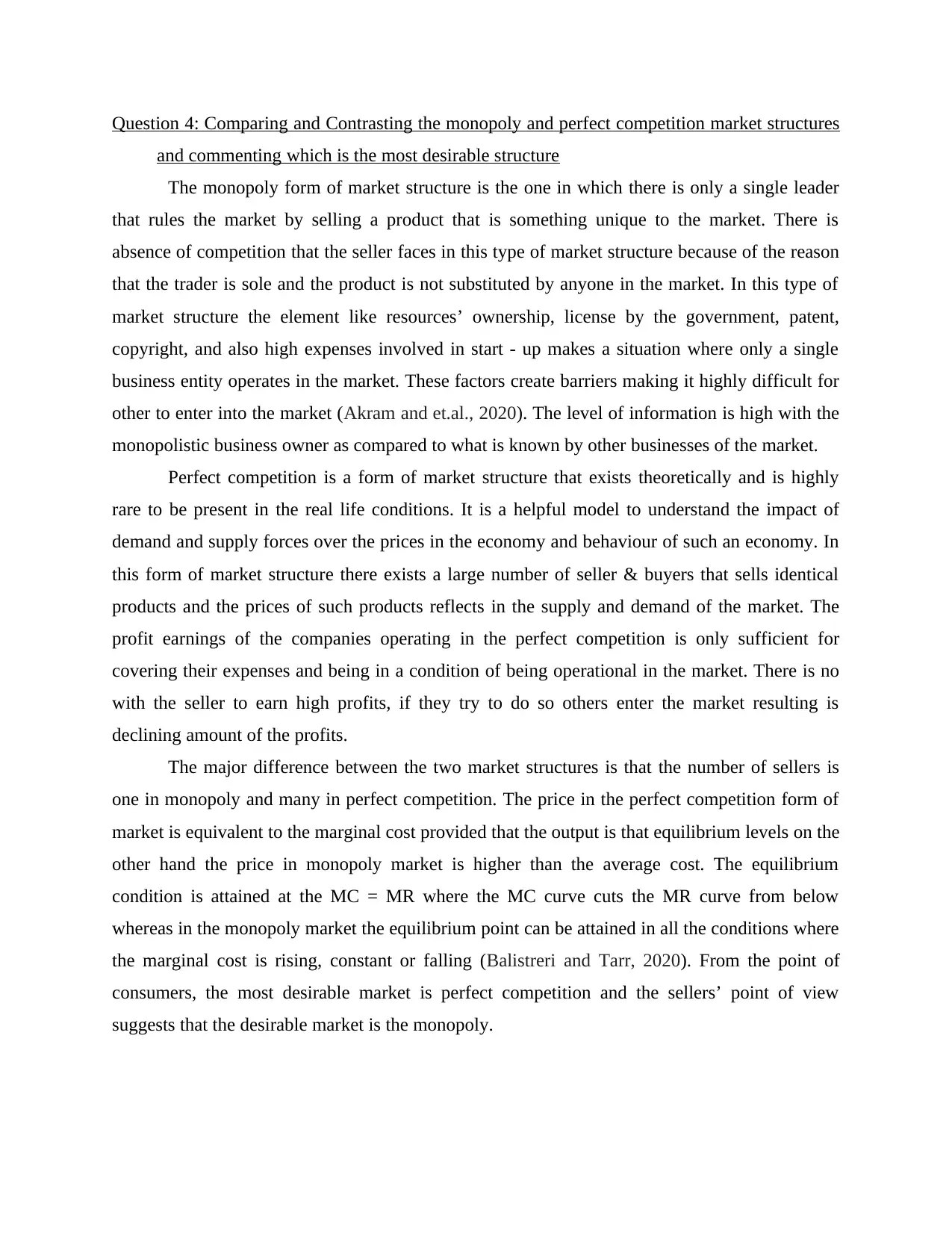
Question 4: Comparing and Contrasting the monopoly and perfect competition market structures
and commenting which is the most desirable structure
The monopoly form of market structure is the one in which there is only a single leader
that rules the market by selling a product that is something unique to the market. There is
absence of competition that the seller faces in this type of market structure because of the reason
that the trader is sole and the product is not substituted by anyone in the market. In this type of
market structure the element like resources’ ownership, license by the government, patent,
copyright, and also high expenses involved in start - up makes a situation where only a single
business entity operates in the market. These factors create barriers making it highly difficult for
other to enter into the market (Akram and et.al., 2020). The level of information is high with the
monopolistic business owner as compared to what is known by other businesses of the market.
Perfect competition is a form of market structure that exists theoretically and is highly
rare to be present in the real life conditions. It is a helpful model to understand the impact of
demand and supply forces over the prices in the economy and behaviour of such an economy. In
this form of market structure there exists a large number of seller & buyers that sells identical
products and the prices of such products reflects in the supply and demand of the market. The
profit earnings of the companies operating in the perfect competition is only sufficient for
covering their expenses and being in a condition of being operational in the market. There is no
with the seller to earn high profits, if they try to do so others enter the market resulting is
declining amount of the profits.
The major difference between the two market structures is that the number of sellers is
one in monopoly and many in perfect competition. The price in the perfect competition form of
market is equivalent to the marginal cost provided that the output is that equilibrium levels on the
other hand the price in monopoly market is higher than the average cost. The equilibrium
condition is attained at the MC = MR where the MC curve cuts the MR curve from below
whereas in the monopoly market the equilibrium point can be attained in all the conditions where
the marginal cost is rising, constant or falling (Balistreri and Tarr, 2020). From the point of
consumers, the most desirable market is perfect competition and the sellers’ point of view
suggests that the desirable market is the monopoly.
and commenting which is the most desirable structure
The monopoly form of market structure is the one in which there is only a single leader
that rules the market by selling a product that is something unique to the market. There is
absence of competition that the seller faces in this type of market structure because of the reason
that the trader is sole and the product is not substituted by anyone in the market. In this type of
market structure the element like resources’ ownership, license by the government, patent,
copyright, and also high expenses involved in start - up makes a situation where only a single
business entity operates in the market. These factors create barriers making it highly difficult for
other to enter into the market (Akram and et.al., 2020). The level of information is high with the
monopolistic business owner as compared to what is known by other businesses of the market.
Perfect competition is a form of market structure that exists theoretically and is highly
rare to be present in the real life conditions. It is a helpful model to understand the impact of
demand and supply forces over the prices in the economy and behaviour of such an economy. In
this form of market structure there exists a large number of seller & buyers that sells identical
products and the prices of such products reflects in the supply and demand of the market. The
profit earnings of the companies operating in the perfect competition is only sufficient for
covering their expenses and being in a condition of being operational in the market. There is no
with the seller to earn high profits, if they try to do so others enter the market resulting is
declining amount of the profits.
The major difference between the two market structures is that the number of sellers is
one in monopoly and many in perfect competition. The price in the perfect competition form of
market is equivalent to the marginal cost provided that the output is that equilibrium levels on the
other hand the price in monopoly market is higher than the average cost. The equilibrium
condition is attained at the MC = MR where the MC curve cuts the MR curve from below
whereas in the monopoly market the equilibrium point can be attained in all the conditions where
the marginal cost is rising, constant or falling (Balistreri and Tarr, 2020). From the point of
consumers, the most desirable market is perfect competition and the sellers’ point of view
suggests that the desirable market is the monopoly.
Paraphrase This Document
Need a fresh take? Get an instant paraphrase of this document with our AI Paraphraser
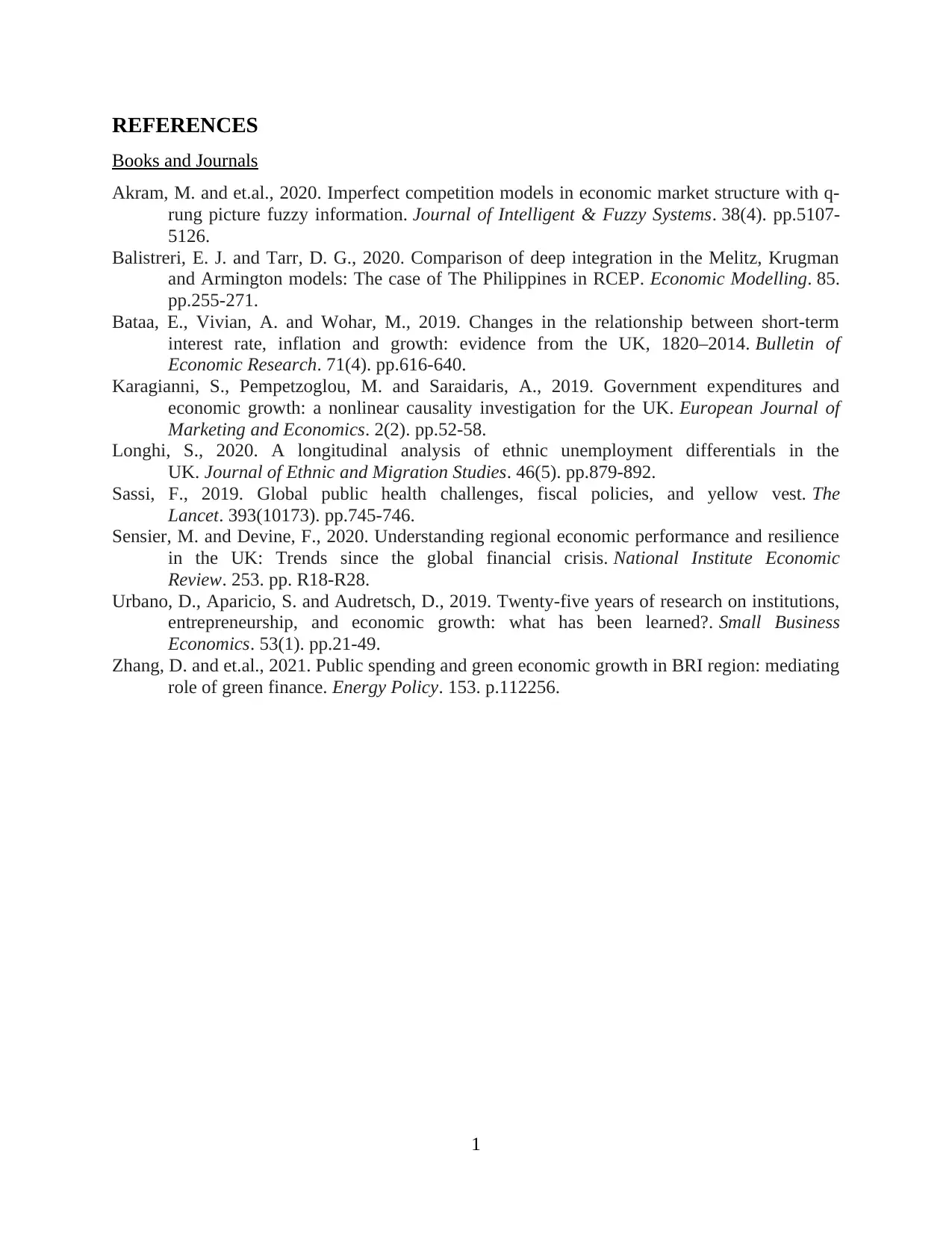
REFERENCES
Books and Journals
Akram, M. and et.al., 2020. Imperfect competition models in economic market structure with q-
rung picture fuzzy information. Journal of Intelligent & Fuzzy Systems. 38(4). pp.5107-
5126.
Balistreri, E. J. and Tarr, D. G., 2020. Comparison of deep integration in the Melitz, Krugman
and Armington models: The case of The Philippines in RCEP. Economic Modelling. 85.
pp.255-271.
Bataa, E., Vivian, A. and Wohar, M., 2019. Changes in the relationship between short‐term
interest rate, inflation and growth: evidence from the UK, 1820–2014. Bulletin of
Economic Research. 71(4). pp.616-640.
Karagianni, S., Pempetzoglou, M. and Saraidaris, A., 2019. Government expenditures and
economic growth: a nonlinear causality investigation for the UK. European Journal of
Marketing and Economics. 2(2). pp.52-58.
Longhi, S., 2020. A longitudinal analysis of ethnic unemployment differentials in the
UK. Journal of Ethnic and Migration Studies. 46(5). pp.879-892.
Sassi, F., 2019. Global public health challenges, fiscal policies, and yellow vest. The
Lancet. 393(10173). pp.745-746.
Sensier, M. and Devine, F., 2020. Understanding regional economic performance and resilience
in the UK: Trends since the global financial crisis. National Institute Economic
Review. 253. pp. R18-R28.
Urbano, D., Aparicio, S. and Audretsch, D., 2019. Twenty-five years of research on institutions,
entrepreneurship, and economic growth: what has been learned?. Small Business
Economics. 53(1). pp.21-49.
Zhang, D. and et.al., 2021. Public spending and green economic growth in BRI region: mediating
role of green finance. Energy Policy. 153. p.112256.
1
Books and Journals
Akram, M. and et.al., 2020. Imperfect competition models in economic market structure with q-
rung picture fuzzy information. Journal of Intelligent & Fuzzy Systems. 38(4). pp.5107-
5126.
Balistreri, E. J. and Tarr, D. G., 2020. Comparison of deep integration in the Melitz, Krugman
and Armington models: The case of The Philippines in RCEP. Economic Modelling. 85.
pp.255-271.
Bataa, E., Vivian, A. and Wohar, M., 2019. Changes in the relationship between short‐term
interest rate, inflation and growth: evidence from the UK, 1820–2014. Bulletin of
Economic Research. 71(4). pp.616-640.
Karagianni, S., Pempetzoglou, M. and Saraidaris, A., 2019. Government expenditures and
economic growth: a nonlinear causality investigation for the UK. European Journal of
Marketing and Economics. 2(2). pp.52-58.
Longhi, S., 2020. A longitudinal analysis of ethnic unemployment differentials in the
UK. Journal of Ethnic and Migration Studies. 46(5). pp.879-892.
Sassi, F., 2019. Global public health challenges, fiscal policies, and yellow vest. The
Lancet. 393(10173). pp.745-746.
Sensier, M. and Devine, F., 2020. Understanding regional economic performance and resilience
in the UK: Trends since the global financial crisis. National Institute Economic
Review. 253. pp. R18-R28.
Urbano, D., Aparicio, S. and Audretsch, D., 2019. Twenty-five years of research on institutions,
entrepreneurship, and economic growth: what has been learned?. Small Business
Economics. 53(1). pp.21-49.
Zhang, D. and et.al., 2021. Public spending and green economic growth in BRI region: mediating
role of green finance. Energy Policy. 153. p.112256.
1
1 out of 8
Related Documents
Your All-in-One AI-Powered Toolkit for Academic Success.
+13062052269
info@desklib.com
Available 24*7 on WhatsApp / Email
![[object Object]](/_next/static/media/star-bottom.7253800d.svg)
Unlock your academic potential
© 2024 | Zucol Services PVT LTD | All rights reserved.



